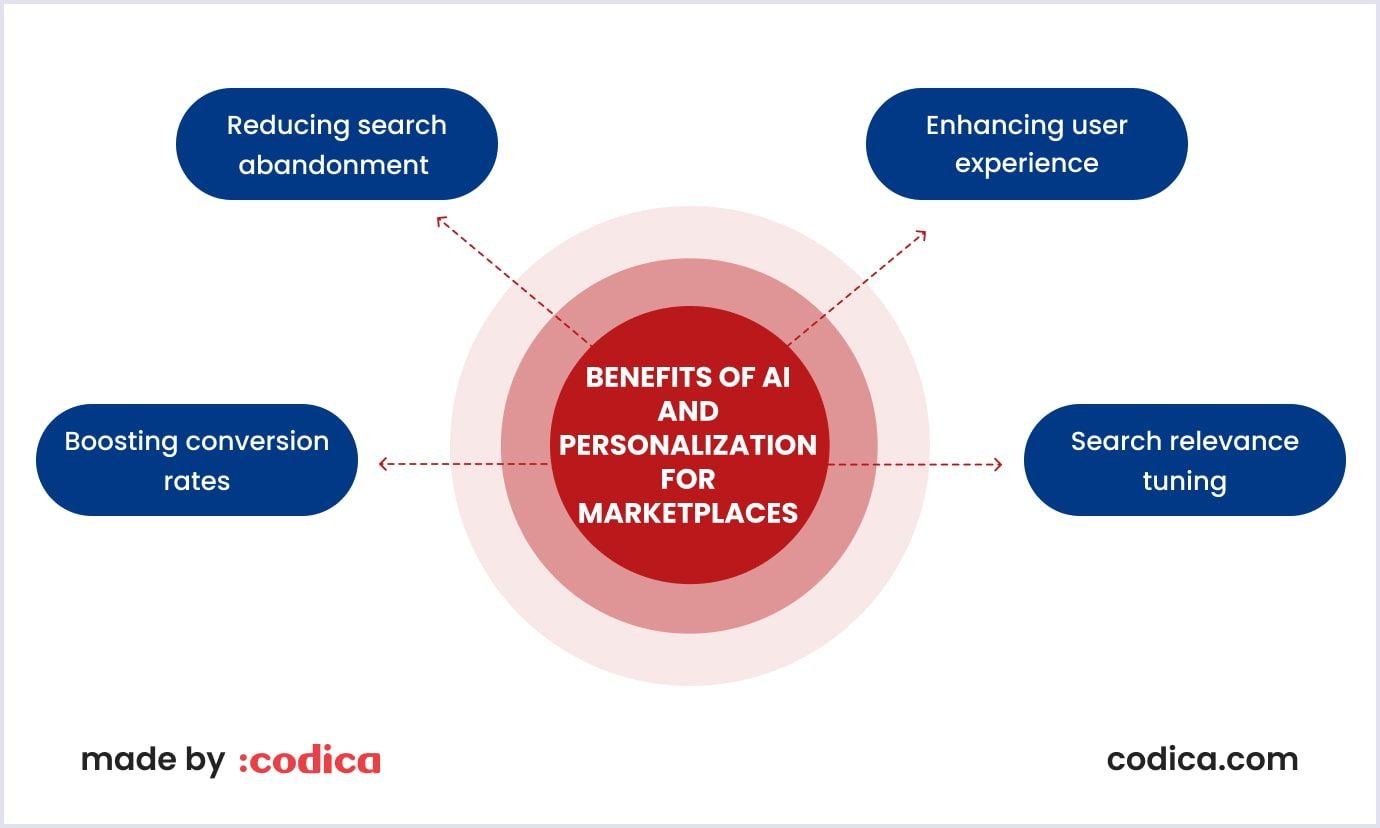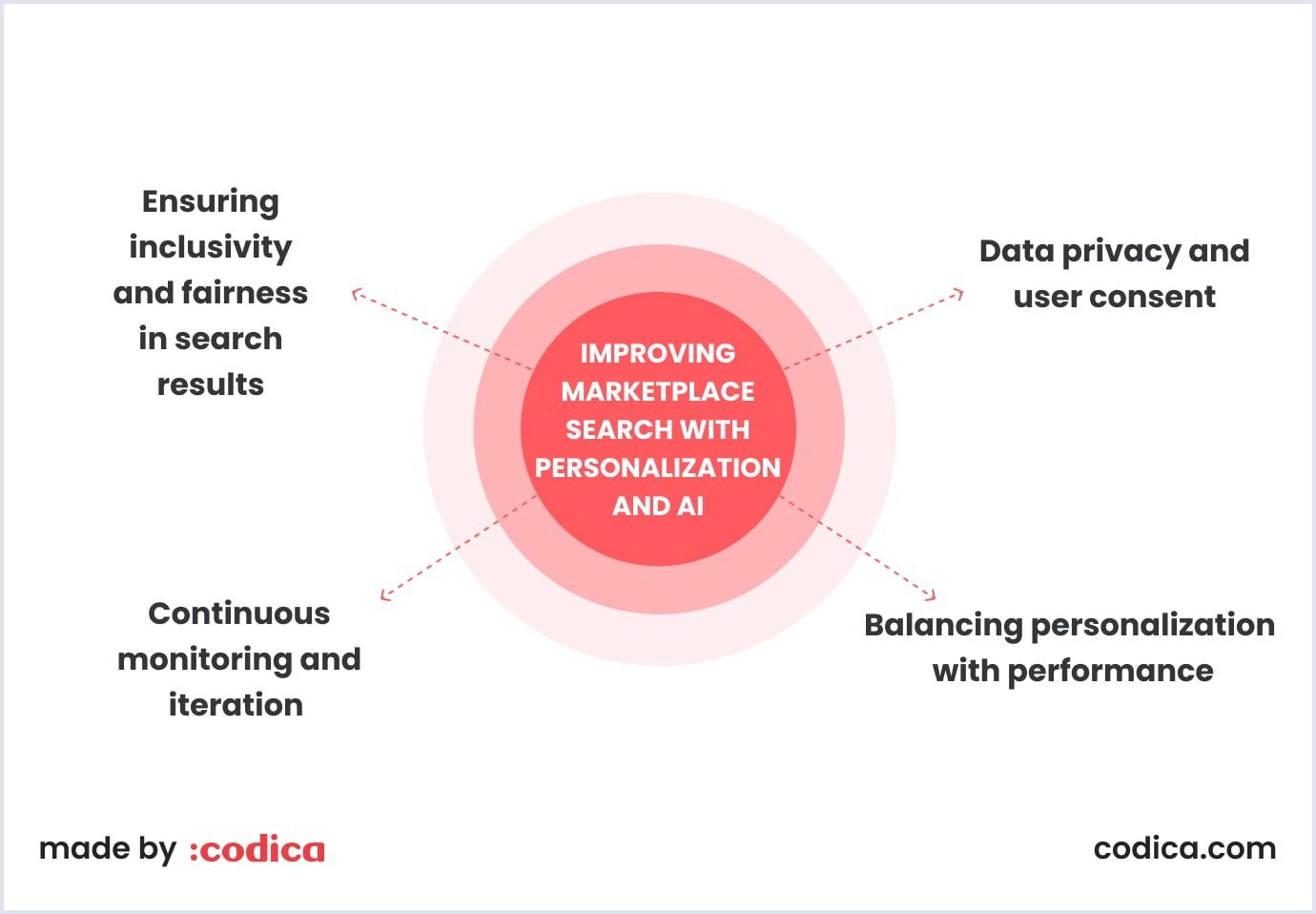In marketplaces, the search system shapes the way shoppers work with your platform. It influences their behavior, evoking certain behavioral patterns. In turn, they have an effect on your metrics, sales, and overall performance.
Previously, we already looked into Algolia and Elastic separately, outlining how each of them can improve your marketplace’s search. In this piece, let’s compare them, overviewing how to implement both and how they can improve personalization on your platform.
Why AI and personalization matter in marketplace search
With ecommerce search engines like Elastic or Algolia integrated into your marketplace search system, you open space for an enhanced shopping experience, which would be super challenging to set up without these tools. At this point, benefits don’t end.

Enhancing user experience
With thorough user behavior and preferences analyzing capabilities, AI-driven personalization can tailor search results for all unique needs users may have. Consequently, your marketplace becomes able to suggest products that are more relevant to individual shoppers.
Look at it this way: a user who frequently purchases eco-friendly products might see more green-certified items at the top of their search results. This personal touch makes the shopping experience more engaging and user-friendly, generally saving your users’ time and effort.
Search relevance tuning
AI algorithms work to refine search queries and return results that better match user intent. With natural language processing (NLP) and machine learning (ML) models, Elastic and Algolia can understand the context behind certain search terms.
This results in more accurate matches between what the user is looking for and the products available, improving the chances of them finding the right items quickly.
Boosting conversion rates
When the marketplace suggests users relevant products through personalized search, they are more likely to complete their purchases. AI-driven personalization increases the visibility of products that align with user preferences, helping users discover items they may not have thought to search for.
This seamless experience, where the right product is suggested at the right time, reduces friction when people are shopping, ultimately increasing conversion rates.
Reducing search abandonment
Personalization also plays a key role in reducing search abandonment. When search results are too generic or irrelevant, users may leave the marketplace out of frustration. By quickly delivering tailored, accurate results, AI-driven personalization keeps users engaged, ensuring they find what they need without the hassle.
In the long run, personalization can reduce the chances of your users abandoning their search altogether, leading to improved user retention and satisfaction.
Comparing Algolia and Elasticsearch for AI-powered search
Performance and speed
When comparing Algolia and Elasticsearch, one of the key differentiators is the performance and speed both of them provide.
- Algolia is known for its real-time search capabilities, delivering search results with lightning speed as users type, making it ideal for applications where immediate response times are critical. This is achieved through Algolia’s highly optimized search-as-you-type feature.
- Elasticsearch for marketplaces excels in large-scale indexing, efficiently handling massive datasets and complex queries. It offers flexibility in tuning and optimizing performance for more intricate search scenarios, making it a powerful choice for marketplaces with a substantial volume of data.

Search relevance and personalization
Both Algolia and Elasticsearch handle search relevance and personalization in unique ways.
- Algolia’s AI-powered features, like dynamic re-ranking and personalization, automatically adjust search results based on user preferences, behavior, and intent.
- Elasticsearch, while not inherently AI-driven, offers extensive customization options. Businesses can fine-tune relevance through sophisticated query structures and machine learning models integrated into the Elasticsearch ecosystem. Although Elasticsearch may require more manual effort to implement personalization, it provides unmatched flexibility for those who need granular control over search behavior.
Integration and scalability
In terms of AI search engine integration and its scalability, both platforms offer robust solutions but with different strengths.
- Algolia is often praised for its ease of integration, providing ready-to-use APIs and extensive documentation that allow developers to quickly implement it into their systems. It scales efficiently for dynamic, high-traffic marketplaces due to its cloud-based infrastructure.
- Elasticsearch, while offering excellent scalability, requires more effort to integrate and manage, especially for larger deployments. However, Elasticsearch’s scalability is more suitable for massive datasets and complex multi-vendor marketplaces, providing more control over infrastructure and scaling as business needs grow.
Data analytics and insights
Data analytics and reporting capabilities are crucial for optimizing marketplace search performance, and both platforms offer distinct advantages.
- Algolia provides built-in analytics tools that help track user interactions, search trends, and performance metrics with minimal setup. Its dashboard allows businesses to gain insights and make data-driven decisions to improve relevance and user experience.
- Elasticsearch, being more customizable, offers advanced capabilities for data analysis through the Elastic Stack (ELK). Businesses can leverage Kibana to visualize search performance, user behavior, and system metrics, making Elasticsearch a better choice for companies that need deeper insights and more tailored analytics.
Cost and licensing
Cost is a significant consideration when choosing between Algolia and Elasticsearch.
- Algolia operates on a tiered pricing model based on usage, with clear and predictable pricing for businesses that need real-time search with minimal setup. However, its costs can scale quickly as traffic and search volume increase.
- Elasticsearch, being open-source, offers more flexible licensing options. While Elasticsearch itself is free to use, additional costs can arise from infrastructure, maintenance, and premium features such as Elastic Cloud. For companies with larger in-house development teams, Elasticsearch may be more cost-effective, but Algolia is often preferred for those seeking a simpler, managed solution.
Below, we'll lay out all the important aspects in a table to make it easier for you to compare.
| Feature | Algolia | Elasticsearch |
|---|---|---|
| Performance and speed | Real-time search with instant results; optimized for speed and search-as-you-type experiences. | Powerful indexing, ideal for handling large datasets and complex queries efficiently. |
| Search relevance and personalization | AI-powered features like dynamic re-ranking andbased on user behavior and intent. | Extensive customization options for relevance and personalization through flexible query structures and integration with machine learning models. |
| Integration and scalability | Easy to integrate with ready-to-use APIs; cloud-based infrastructure for efficient scaling in dynamic, high-traffic environments. | More complex integration but offers greater control over infrastructure; highly scalable for large, multi-vendor marketplaces. |
| Marketplace data analytics and insights | Built-in analytics tools for user behavior tracking search, trends analysis, and performance metrics via a user-friendly dashboard. | Advanced analytics capabilities with the Elastic Stack (ELK), using Kibana for deeper data visualization and tailored reporting. |
| Cost and licensing | Tiered pricing model based on usage; costs can scale with traffic. | Open-source with free core features; additional costs for infrastructure, maintenance, and premium services like Elastic Cloud. |
Comparing the implementation of Algolia and Elastic
Previously, we had already looked into setting up both Elastic and Algolia. Now, let’s compare them side-by-side, highlighting the unique steps you have to take to fine-tune them for your marketplace. Notably, each platform follows its unique approach to personalization, with varying steps and tools for configuration and marketplace search optimization.
| Step | Algolia | Elasticsearch |
|---|---|---|
| Step 1: Setup | Create an Algolia account, set up product and user indices, and configure basic settings. | Set up an Elasticsearch cluster, define indices for user and product data, and configure settings. |
| Step 2: Search and ranking rules | Configure search and ranking rules by prioritizing user attributes and preferences to deliver personalized results. | Create custom search queries and configure boosting rules to highlight relevant products or categories based on user profiles. |
| Step 3: Personalization features | Use Algolia’s built-in tools for tracking user behavior, making personalized recommendations, and ranking dynamic products. | Integrate machine learning in search to personalize search and improve relevance based on user behavior. |
| Step 4: Real-time data handling | Algolia provides real-time tracking and personalization updates directly within its platform. | Use Logstash or Beats for real-time data ingestion, ensuring search indices reflect user interactions immediately. |
| Step 5: | Utilize Algolia’s analytics tools to test and optimize ecommerce personalization strategies based on feedback and user behavior. | Leverage Elasticsearch's monitoring tools (via Kibana) to analyze behavior and refine personalization algorithms. |
| Step 6: Analytics and continuous improvement | Use Algolia’s built-in real-time search analytics to monitor performance and track user interactions for ongoing improvement. | Employ the Elastic Stack (ELK) to gain deeper insights and continuously tailor personalization strategies. |
Read also: 10 Tips on Implementing AI the Right Way
Best practices for leveraging AI and personalization in marketplace search
You can use AI and personalization strategies to improve your search system in many ways. Some of them aim at performance improvements, while others provide space for regular monitoring and refinement. Either way, here are several practices you should definitely take hold of when implementing Elastic and/or Algolia.

Data privacy and user consent
It’s no secret that AI-powered search personalization techniques work primarily on user data to tailor search results and enhance relevance. In this regard, the question of user privacy is paramount. Here’s how you can address it:
- Be transparent in data collection. Inform users about what data is being collected and how it will be used.
- Opt-in consent. Always provide users with clear opt-in mechanisms for personalized search in ecommerce. This ensures compliance with privacy regulations such as GDPR and CCPA.
- User controls. Offer easy ways for users to manage their personalization settings or opt-out if they prefer a standard search experience.
- Data security. Use encryption and anonymization techniques to protect sensitive information throughout the data lifecycle.
Balancing personalization with performance
Personalization can enhance relevance, but it must not slow down search performance, as users expect fast and responsive results. Here’s a way for you to maintain that balance:
- Efficient indexing. Pre-compute personalized search recommendations or use dynamic caching to minimize query processing times.
- Segmented personalization. Apply lightweight personalization techniques, such as showing personalized categories, without compromising core search speed.
- A/B testing. Experiment with different degrees of personalization to find the optimal trade-off between relevance and performance.
- Server optimization. Use distributed search systems and cloud computing to handle increased loads without latency issues.

Continuous monitoring and iteration
User preferences and behaviors change over time, requiring marketplaces to adopt a continuous feedback loop for their AI-powered search strategies. There are several aspects you should monitor and be aware of.
- Performance metrics. Track key metrics that define your marketplace’s success. These often include click-through rates (CTRs), search churn, and conversion rates. However, you may want to follow other metrics since they may be more relevant to your platform.
- Behavioral data analysis. Monitor how users interact with search results and refine algorithms to align with evolving behavior.
- Real-time adaptation. Implement systems capable of real-time learning to adjust to seasonal trends or sudden shifts in demand.
- Ongoing improvements. Use machine learning models that can retrain periodically, incorporating new data for better predictions and recommendations.
Ensuring inclusivity and fairness in search results
AI and personalization algorithms can unintentionally introduce biases, which may skew results in favor of certain vendors or products. A fair AI marketplace search experience ensures inclusivity and diversity. You can address this issue like so:
- Bias auditing. Make sure to inspect algorithms regularly to identify and minimize any potential biases, like favoring large vendors over small ones.
- Diverse training data. Use representative data across demographics, product categories, and vendor sizes to ensure fairness in personalized results.
- Vendor equity mechanisms. Implement rules that rotate product visibility or limit the dominance of certain vendors in search results.
- User feedback channels. Allow users to report unfair or irrelevant results, feeding this feedback into the algorithm for continuous improvement.
Bottom line
Clearly, a search system is a cornerstone of any successful ecommerce platform. Both Elastic and Algolia provide functionality that is good enough to improve your marketplace and affect metrics significantly. Therefore, the choice is up to you, and hopefully, this article will provide enough facts to support the adoption of either Elastic or Algolia.
Marketplaces, however, can be improved in dozens of other ways. Feel free to check out our blog, where Codica experts regularly cover various industry intricacies, be it multi-vendor marketplaces, ecommerce solutions, or even the SaaS cloud platforms.
As a marketplace development company, we have extensive expertise not only in overviewing but also in developing marketplaces, varying in scale, style, and business models. Hence, feel free to contact us if you’re planning to build one. Our sales team will gladly guide you through all the processes, providing examples of projects already finished from our portfolio.

